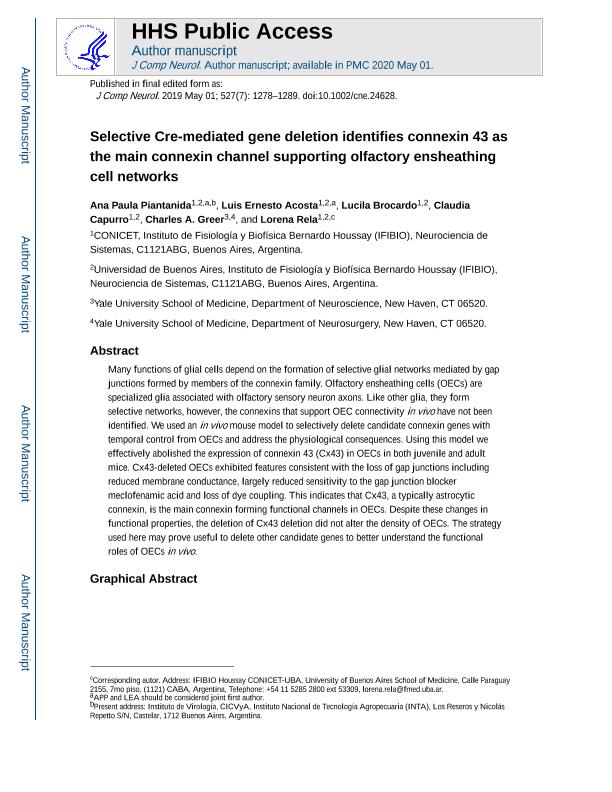Artículo
Selective Cre-mediated gene deletion identifies connexin 43 as the main connexin channel supporting olfactory ensheathing cell networks
Piantanida, Ana Paula ; Acosta, Luis Ernesto; Brocardo, Lucila
; Acosta, Luis Ernesto; Brocardo, Lucila ; Capurro, Claudia Graciela
; Capurro, Claudia Graciela ; Greer, Charles A.; Rela, Lorena
; Greer, Charles A.; Rela, Lorena
 ; Acosta, Luis Ernesto; Brocardo, Lucila
; Acosta, Luis Ernesto; Brocardo, Lucila ; Capurro, Claudia Graciela
; Capurro, Claudia Graciela ; Greer, Charles A.; Rela, Lorena
; Greer, Charles A.; Rela, Lorena
Fecha de publicación:
05/2019
Editorial:
Veterinary and Human Toxicology
Revista:
Journal Of Comparative Neurology
ISSN:
0021-9967
Idioma:
Inglés
Tipo de recurso:
Artículo publicado
Clasificación temática:
Resumen
Many functions of glial cells depend on the formation of selective glial networks mediated by gap junctions formed by members of the connexin family. Olfactory ensheathing cells (OECs) are specialized glia associated with olfactory sensory neuron axons. Like other glia, they form selective networks, however, the connexins that support OEC connectivity in vivo have not been identified. We used an in vivo mouse model to selectively delete candidate connexin genes with temporal control from OECs and address the physiological consequences. Using this model, we effectively abolished the expression of connexin 43 (Cx43) in OECs in both juvenile and adult mice. Cx43-deleted OECs exhibited features consistent with the loss of gap junctions including reduced membrane conductance, largely reduced sensitivity to the gap junction blocker meclofenamic acid and loss of dye coupling. This indicates that Cx43, a typically astrocytic connexin, is the main connexin forming functional channels in OECs. Despite these changes in functional properties, the deletion of Cx43 deletion did not alter the density of OECs. The strategy used here may prove useful to delete other candidate genes to better understand the functional roles of OECs in vivo.
Archivos asociados
Licencia
Identificadores
Colecciones
Articulos(IFIBIO HOUSSAY)
Articulos de INSTITUTO DE FISIOLOGIA Y BIOFISICA BERNARDO HOUSSAY
Articulos de INSTITUTO DE FISIOLOGIA Y BIOFISICA BERNARDO HOUSSAY
Citación
Piantanida, Ana Paula; Acosta, Luis Ernesto; Brocardo, Lucila; Capurro, Claudia Graciela; Greer, Charles A.; et al.; Selective Cre-mediated gene deletion identifies connexin 43 as the main connexin channel supporting olfactory ensheathing cell networks; Veterinary and Human Toxicology; Journal Of Comparative Neurology; 527; 7; 5-2019; 1278-1289
Compartir
Altmétricas



